The United States is abundant with species of fish that anglers love, but it can be difficult to get the right gear if you want to target multiple species. To help with this we have put together a guide to show common North Amercian Fish Species for Anglers, how to catch them, recommended gear, and popular bait so you can select the right equipment for your local area.
Most fish species can be split up into a few categories – freshwater, saltwater, and big gamefish.
Generally freshwater fish are smaller and require lighter gear than saltwater fish. Gamefish are in a world of their own and requires dedicated, specialist equipment that can be very heavy and expensive.
| Fish Species | Recommended Fishing Reel | Recommended Fishing Rod | Best Bait |
|---|---|---|---|
| Bass | Spinning reel, 2000-3000 size | 6-7 ft, medium to medium-heavy power, fast action | Plastics, spinnerbaits, crankbaits, jigs |
| Trout | Spinning reel, 1000-2500 size | 6-7 ft, light to medium power, moderate-fast action | Spinners, spoons, live bait (worms, insects) |
| Salmon | Baitcasting reel, 15-20 lb line capacity | 8-10 ft, medium-heavy power, fast action | Plugs, spoons, flies, roe |
| Redfish | Spinning reel, 3000-4000 size | 7-8 ft, medium-heavy power, fast action | Shrimp, crabs, spoons, soft plastics |
| Pike | Baitcasting reel, 20-30 lb line capacity | 7-9 ft, medium-heavy to heavy power, fast action | Spoons, spinners, crankbaits, live bait (fish) |
| Catfish | Spinning reel, 4000-6000 size | 7-9 ft, medium-heavy to heavy power, moderate-fast action | Cut bait, stink bait, chicken liver, nightcrawlers |
| Carp | Spinning reel, 4000-6000 size | 10-12 ft, medium to medium-heavy power, moderate action | Corn, boilies, dough baits |
| Tarpon | Spinning reel, 6000-8000 size | 7-9 ft, heavy power, fast action | Live bait (mullet, crabs), artificial lures |
| Tuna | Conventional reel, 30-80 lb line capacity | 5-7 ft, heavy power, fast action | Live bait (sardines, squid), trolling lures |
| Snook | Spinning reel, 3000-5000 size | 7-8 ft, medium-heavy power, fast action | Live bait (shrimp, mullet), artificial lures |
| Walleye | Spinning reel, 2000-3000 size | 6-7 ft, medium power, fast action | Jigs, crankbaits, live bait (minnows, leeches) |
| Crappie | Spinning reel, 1000-2000 size | 5-7 ft, light power, moderate-fast action | Small jigs, minnows, spinners |
| Perch | Spinning reel, 1000-2000 size | 5-6 ft, light power, moderate-fast action | Live bait (minnows, worms), small jigs |
| Bluegill | Spinning reel, 500-1000 size | 5-6 ft, ultralight power, moderate action | Live bait (worms, crickets), small jigs |
| Mackerel | Spinning reel, 3000-5000 size | 7-9 ft, medium to medium-heavy power, fast action | Live bait (anchovies, sardines), spoons, jigs |
| Barracuda | Spinning reel, 4000-6000 size | 7-9 ft, medium-heavy power, fast action | Artificial lures, live bait (fish) |
| Sturgeon | Conventional reel, 50-80 lb line capacity | 8-10 ft, heavy power, moderate-fast action | Cut bait, nightcrawlers, roe |
| Cobia | Spinning reel, 5000-7000 size | 7-8 ft, medium-heavy to heavy power, fast action | Live bait (crabs, eels), artificial lures |
| Wahoo | Conventional reel, 30-50 lb line capacity | 5-7 ft, heavy power, fast action | High-speed trolling lures, skirted lures, live bait (mullet, bonito) |
| Roosterfish | Spinning reel, 5000-8000 size | 8-9 ft, medium-heavy to heavy power, fast action | Live bait (mullet, sardines), poppers, stickbaits |
| Sailfish | Conventional reel, 20-50 lb line capacity | 6-7 ft, medium-heavy to heavy power, fast action | Live bait (goggle eyes, pilchards), skirted lures |
| Marlin | Conventional reel, 50-130 lb line capacity | 5-7 ft, heavy to extra-heavy power, fast action | Trolling lures, live bait (mackerel, bonito) |
| Mahi Mahi | Spinning or conventional reel, 20-50 lb line capacity | 6-7 ft, medium-heavy to heavy power, fast action | Trolling lures, live bait (squid, ballyhoo) |
Have a read through our guide below, find the fish that live in your local areas and you should be able to get a clear idea of what equipment you will need.
Table of Contents
Bass
Bass fish are a species of freshwater fish. They are known for their large size, fearsome appearance, and predatory behavior. Bass fish are carnivorous and tend to eat smaller fish, frogs and insects that fall into the water. This makes them popular among anglers who enjoy fishing for sport and food. The various types of bass fish have different colors, sizes and shapes.
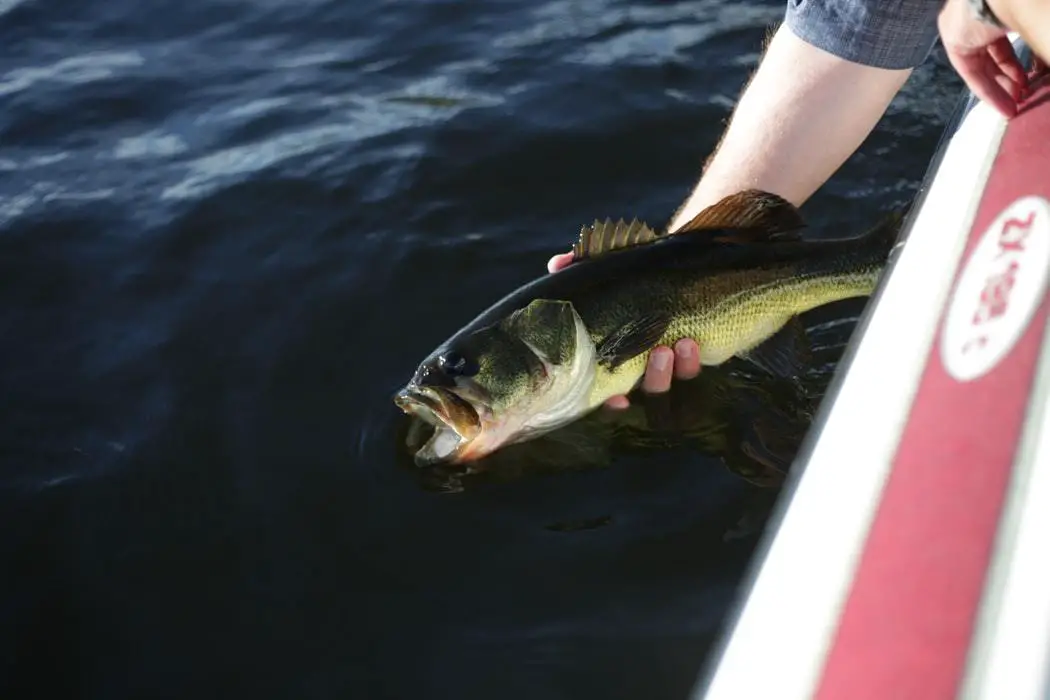
Where to Find:
- Bass are found throughout North America in many lakes and rivers.
- Adjust your depth and position based on the season.
How to Catch:
- Look for bass around structure or weed beds. Cast your crankbait to the edge of the sea weed to entice the bass out from their hiding spot.
Recommended Gear:
- Reel – Spinning or Baitcasting reel with around a 6.4:1 gear ratio
- Rod – Spinning or Baitcasting rod around 6-7″ long with a fast action and medium power
- Fishing Line – 6 – 10 pound mono
Best Bait:
- 3/8 to 6/8 oz crankbait
Trout
Trout are the members of the genus Salmonidae, most often found in freshwater environments in the Northern Hemisphere. There are many species of trout, and they live in both cold-water and warm-water habitats. They are highly valued for sport fishing due to their fighting abilities, vigorous growth rates and easy preparation.

Where to Find:
- Trout are found in many places throughout North America. Look for them in fast moving rivers with gravel bottoms
How to Catch:
Recommended Gear:
- Rod – Ultralight 7 foot rod with a fast action
- Reel – Ultralight spinning reel or fly fishing reel
- Fishing Line – 6-10 lb mono
Best Bait:
- Popular natural bait for trout are worms, minnows, maggots, yabbies, crickets, and grasshoppers. There are also plenty of artificial lures that are successful in catching trout.
Salmon
Salmon is a fish of the family Salmonidae that also includes trout, char and whitefish. Most salmon are anadromous: they hatch in fresh water, migrate to the ocean, then return to fresh water to reproduce. Salmon have been widely introduced into non-native environments such as the Great Lakes of North America. Salmon are intensively farmed in many parts of the world.

Where to Find:
- Salmon are found in the North of the United States in particular around the Pacific States
How to Catch:
- Salmon are popular amongst fly fisherman but can be caught with a spinning reel as well
Recommended Gear:
- Rod – 8-9 foot lightweight fly rod
- Reel – 8/9 or 9/10 sized fly reel
- Fishing Line – 10-15 lb mono line
Best Bait:
- Salmon eggs, herring and sand shrimp are popular natural baits for salmon
Redfish
Red drum fish is a kind of marine fish that belongs to the family Sciaenidae. It is also known as redfish, channel bass, red bass and rockfish. Red drum fish has been one of the best game fish in North America since its discovery. People who have tasted this fish have surely fallen in love with it.
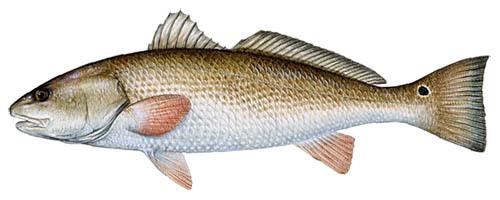
Where to Find:
- Redfish or Red Drum are widespread from Texas to Florida.
- Redfish are popular among anglers because they habitat so many different environments and you can find them just about anywhere.
How to Catch:
- Keep your eyes open for redfish tailing – this occurs when a redfish is bottom feeding in shallow water and their tails come out of the water.
Recommended Gear:
- Rod – 6 to 7 foot medium action spinning rod like an Ugly Stik GX2
- Reel – Light to medium weight 2000-3000 size spinning reel
- Fishing Line – 12-15 lb mono line
Best Bait:
- The most popular bait for redfish is fresh mullet as well as artificial crankbaits
Pike
Pike fish are carnivorous freshwater fish. They have an elongated body and a flattened head with a sharp snout, which is used for hunting. Pike fish feed on other fish, frogs, worms and small mammals. Their teeth can crush bones easily due to their unique structure. Some species also prey on swimming birds that come too close to the water surface by jumping out of the water to attack them in flight.
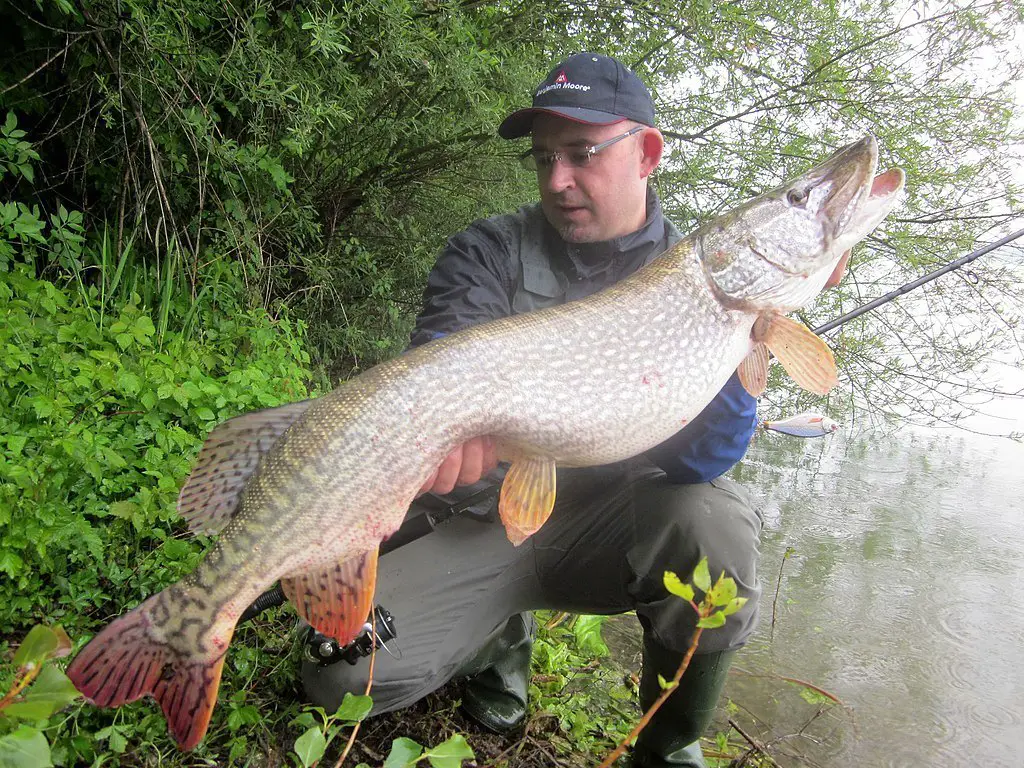
Where to Find:
- There are plenty of locations in the northern United States if you want to go for pike fishing. All you need is a keen eye, and know which places to visit and before you know it, you will be hooking this trophy fish
- Some popular locations are the Madison Chain, Green Bay, and Lake Onalaska
How to Catch:
- Until you find the ideal location, start off with a mix of trolling and casting.
- Always try opting for a natural food source for the fish such as dead baits.
Recommended Gear:
- Rod – 8-12 foot long Spinning Reel
- Reel – Medium to Heavy 5000-8000 sized Spinning Reel
- Fishing Line – 12-15 lb mono line with a wire trace
Best Bait:
- The best bait for pike are minnows for small pike and live perch for large pike as well as spinnerbaits and spoons
Catfish
Catfish are a diverse group of ray-finned fish. Named for their prominent barbels, which resemble a cat’s whiskers, catfish range in size and behavior from the heaviest and longest, the Mekong giant catfish from Southeast Asia and the second longest, the wels catfish of Eurasia, to detritivores (species that eat dead material on the bottom), and even to a small species that lives in streams in New Guinea with light sensitive eyes.
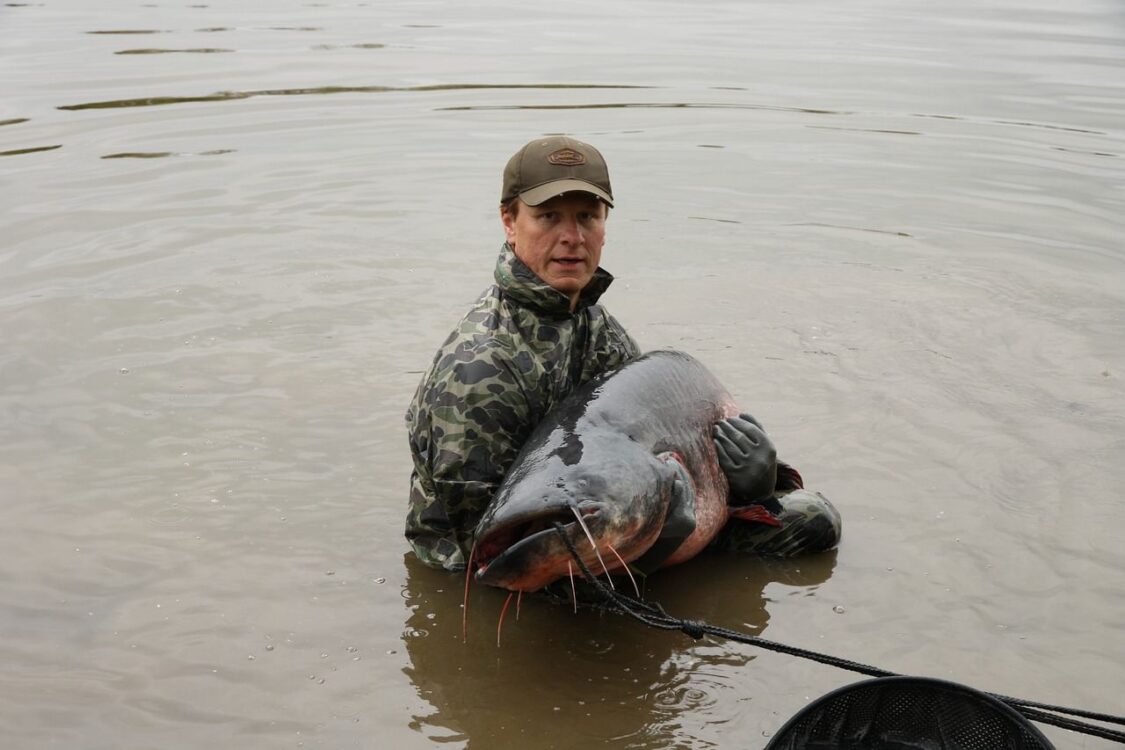
Where to Find:
- Catfish can be found throughout the United States but some key locations include Mississippi River, Lake Texoma, and The Red River, Minnesota.
- Catfish can be caught all year round but are most active in late spring and summer.
- Large catfish often stay in deep holes next to underwater ledges.
How to Catch:
- Set three lines with livebait at different depths to identify the depth that catfish are travelling and then focus when you narrow it down.
Recommended Gear:
- Rod – 7 foot medium to medium-heavy power with moderate-fast action spinning or baitcasting rod
- Reel – spinning or baitcasting reel with high maximum drag.
- Line – 10-12 lb mono with a 20-30 lb fluoro leaders
Best Bait:
- Match the hatch with natural baits like nightcrawlers, frogs, and crawfish or use a powerbait that gives off a pungent smell that attracts catfish.
Carp
Carp are the most widely consumed fish in the world. It is also one of the most important freshwater fish species providing more than 150 million people with food and employment.
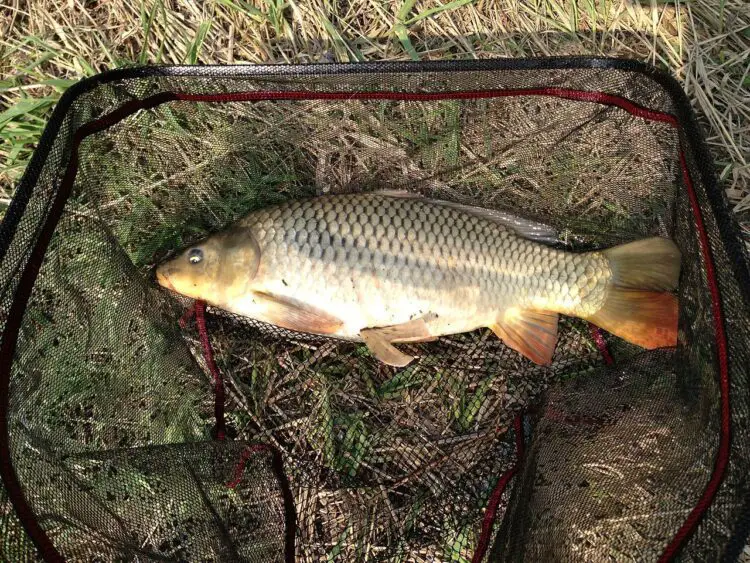
Where to Find:
- Carp are often found hiding in the deeper water near drop offs or shelves
- Carp are extremely hardy and can live in all kinds of environments. Although the most common is large lakes, slow moving rivers, and reservoirs – they are also found in ditches, canals, and small ponds.
How to Catch:
- Look for carp breaching the surface to identify their position and then fish in that area
Recommended Gear:
- Rod – 9 to 12 feet spinning rods
- Reel – Heavy 8000 sized spinning reel
- Fishing Line – 50 lb braid line
Best Bait:
- The most common baits for carp are corn, bread, boilies, and doughball – these can be homemade or bought
Tarpon
Tarpon are large marine fish found in tropical and subtropical waters. Tarpons are the largest member of the genus Megalops. The maximum recorded length for a tarpon is 214 cm (7 ft 4 in), and the maximum reported weight is 300 kg (661 lb).

Where to Find:
- Tarpon is one of the most popular fishing species in Florida.
- When you see a school of tarpon with a good pair of polarized sunglasses, drift with your boat, and cast to the other side of the school, slowly retrieving your lure or live bait through them – and hold on!
How to Catch:
- Put out 3-4 different types of bait at the start to figure out what the tarpon are hungry for.
- Be prepared for the fish to break free – fisherman often talk about how many tarpon they jumped rather than landed as it is very difficult to bring them all the way to the boat.
Recommended Gear:
- Rod – 8 foot spinning rod
- Reel – A spinning reel with 250-300 lbs of line capacity
- Fishing Line – 50-80 lb braid line with 60-80 lb mono leader
Best Bait:
- The most popular bait for tarpon is live baitfish including pilchards, pinfish, minnows, and herring
Tuna
Tuna is a type of fish that belongs to the family of Scombridae. Tuna is a large sized fish and its average size may vary from 5 kg to 1500 kg. Tuna is yellowish in color, with silvery white spots on upper side of body and silver-white on lower side. It has an elongated body that can be seen in many species of this fish. The tuna diet mainly consists of smaller fishes, squid, and cuttlefish.

Where to Find:
- Look for birds – this often highlights a bait ball that tuna feeding under the water have created.
How to Catch:
- Tuna schools are very mobile and can often disappear at a moments notice, so be ready to move as soon as they vanish
- Retrieve your lure as fast as possible – you won’t be able to retrieve faster than a tuna can swim!
Recommended Gear:
- Rod – A heavy conventional boating rod on the stiff side
- Reel – A serious conventional offshore reel with 35-60 pounds of drag
- Fishing Line – 30 lb braid line with fluorocarbon leader
Best Bait:
- Some of the most popular baits for tuna are herring, mullet, squid, mackerel, or skipjack
- There are also plenty of skirted trolling lures that work well with hungry tuna
Snook
Snook are fish belonging to the genus Centropomus, which is part of the sea bass family of Serranidae. The most recognized species in this genus is the snook (Centropomus undecimalis). Snook can be identified by their elongated dorsal fin, which has 10 spines and 9 soft rays. It also possesses a series of black spots above its lateral line. Their anal fin has 3 spines and 5 soft rays.
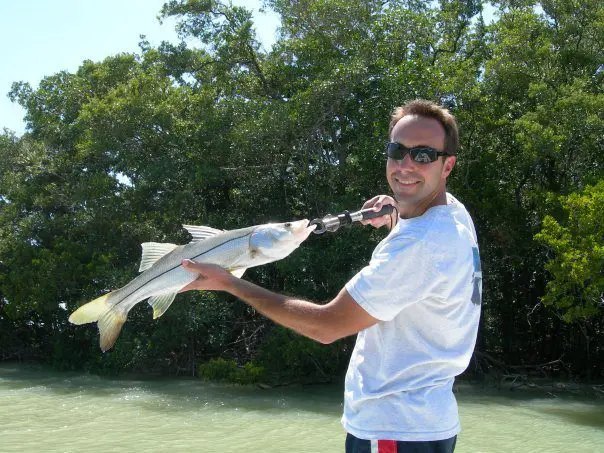
Where to Find:
- Snook can be found in fresh and saltwater generally around mangroves, docks, bridges, and other structure.
How to Catch:
- If you are fishing around mangroves then chum the water with pilchards before casting towards the structure.
- Because they hang around structure there is a risk of breaking line so you will want to use slightly heavier gear than you would expect.
Recommended Gear:
- Rod – Medium action 8 foot long spinning rod
- Reel – 4000 size spinning reel
- Fishing Line – 20-30 lb braid line with 20-30 lb mono leader
Best Bait:
- The best bait for snook are shrimp and sardines
Walleye
Walleye is a freshwater fish that inhabits the northern hemisphere. It has been known as an essential food for Native Americans for thousands of years, and it was introduced to European populations in the 19th century.
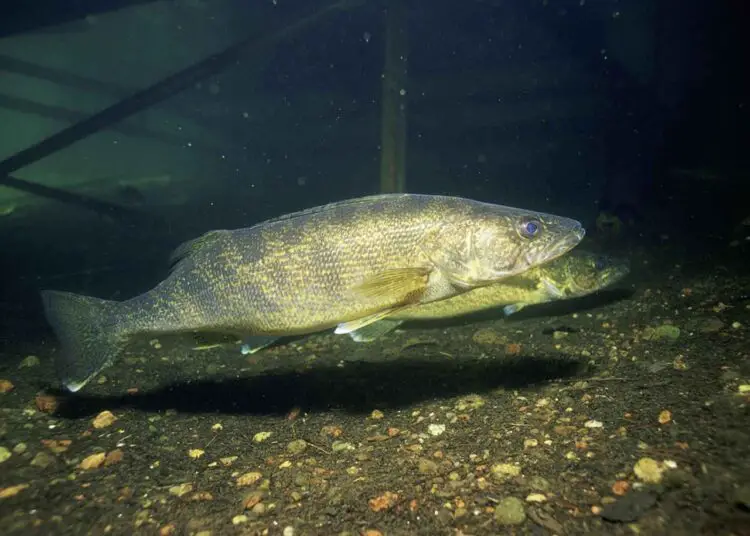
Where to Find:
- Walleye often hide around rocky points and sand bars as well as weed banks and reefs.
How to Catch:
- Fish at dawn or dusk as Walleye hunt in low light conditions, as well as overcast days.
- Cast with crankbaits or bait
Recommended Gear:
- Rod – 6’6″ to 7′ medium action spinning rod
- Reel – Light freshwater spinning reel
- Line – 8-10 lb mono line
- Leader – 2-3 feet of 12-20 lb fluoro
Best Bait:
- The most popular bait for walleye fishing is minnows, leaches, and night-crawlers.
Crappie
Crappie fish are a type of panfish. They belong to the genus Pomoxis, which includes the black and white crappie, bluegill sunfish, and redbreast sunfish. Crappie fish have an elongated body with a rounded snout, large eyes with horizontal pupils, and a dark spot on each scale. This family of fish is native to North America.
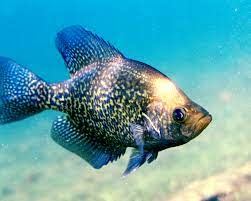
Where to Find:
- Crappie are found in hundreds of lakes throughout the United States
- Look for crappie around deep timber in winter
- As spring increases the water temperature crappie move to shallow coves to spawn
How to Catch:
- Put a smelly bait in a likely place and wait
Recommended Gear:
- Rod – 7 foot ultralight spinning rod
- Reel – Ultralight weight spinning reel
- Fishing Line – 4-10 lb mono line
- Fishing Hooks – 2/0 or 4/0 bait hooks
Best Bait:
- Look for local bugs and match them like crickets or fresh minnows.
- Synthetic bait like Leland Lures Crappie Magnet work well
Perch
Perch are freshwater fish of the family Percidae. They have distinctive red or orange stripes on a lighter body color. The common perch, Perca fluviatilis, is the only species of this genus native to Great Britain and Ireland. It is also found across much of Europe and Asia as far south as Japan, while other species are found in Africa, Australia and North America The perch’s mouth has small teeth that allow it to eat its prey whole.

Where to Find:
- Perch are often found in warmer, shallow waters in spring, but head deeper to 20-25 feet in summer.
How to Catch:
- Look for Perch on your fish finder towards the bottom of the lake. When you identify a prime location then drop bait down to the target depth.
Recommended Gear:
- Rod – Ultralight fast action spinning rod
- Reel – 500 to 2500 size spinning reel
- Fishing Line – 4-8 lb mono line
Best Bait:
- Perch are not picky eaters and some popular baits are minnows, maggots, night crawlers, wax worms and cut bait
Bluegill
The bluegill is a freshwater fish that can be found in the United States, most likely around your local lake or pond. They are very easy to catch and make great bait for larger fish. They primarily feed off of insects, worms, and small crustaceans while they are young but have been known to eat small frogs when they get bigger. The bluegill has a lifespan of three years on average and usually grows to the size of 8 inches long.

Where to Find:
- Bluegill can be found throughout the USA, but are very common in the Great Lakes and Mississippi.
How to Catch:
- Blue gill feed by sight and are most often caught at dawn or dusk.
- They stay close to shore and hide around structure like bridges, banks, and weed beds.
Recommended Gear:
- Rod – Light fast action spinning rod
- Reel – 500 to 2500 size spinning reel
- Fishing Line – 2-6 lb mono line
Best Bait:
- Worms and nightcrawlers are popular bait for bluegill as well as crickets and grasshoppers and artificial lures
Mackerel
Mackerel is a fish that has two dorsal fins. It’s also known as jackfish or horse mackerel. Like other members of the scombridae family, this fish has a silvery-colored body with dark vertical stripes and blue eyes. The species of mackerel can be found in tropical waters around the world, where it lives an average of 5 years to about 14 years. The mackerel is popular for its taste.
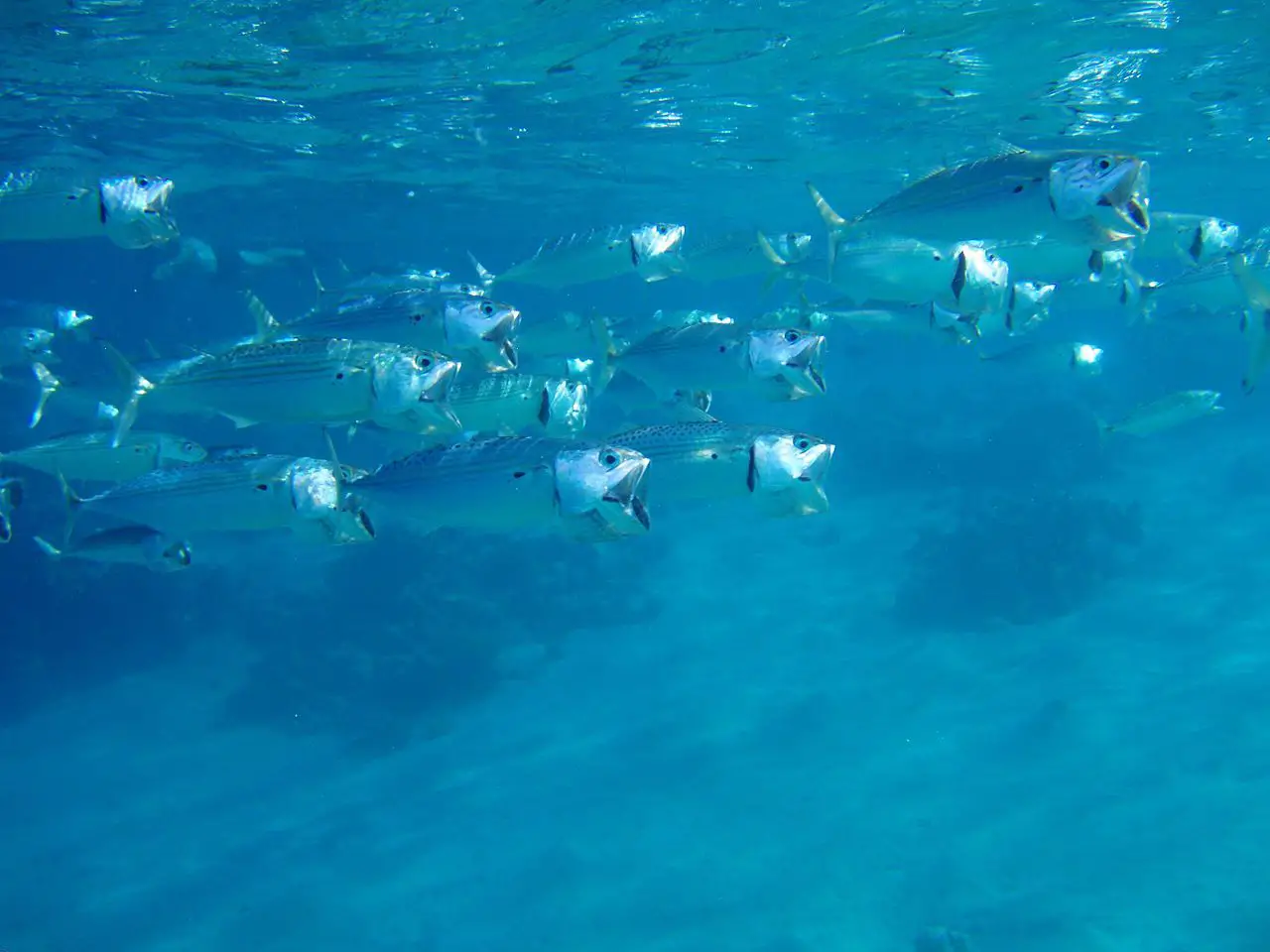
Where to Find:
- Mackerel are found from Northern Mexico to Cape Cod.
- They are a pelagic species which means they are found in the top water column around schools of bait fish.
How to Catch:
- Mackerel can be caught by throwing bait on the outside of bait fish schools where the mackerel are feeding. They can also be caught with hard body lures or soft plastic lures.
Recommended Gear:
- Rod – 6-7 foot spinning or conventional medium action rod
- Reel – 6000 size spinning reel or a light offshore conventional reel
- Fishing Line – 15 lb braid or 15 lb mono line
Best Bait:
- One of the best baits for mackerel is actually other mackerel strips as well as garfish, scad, sand eels, and squid.
Barracuda
The barracuda is a ray-finned species of fish known for its large size, fearsome appearance and voracious appetite. The top of the body is greenish-brown to black, fading to white underneath. The eyes are set high on the head and give it good binocular vision. It has fang-like teeth in both jaws. Barracudas are typically found near the surface of water in tropical oceans and seas around the world.
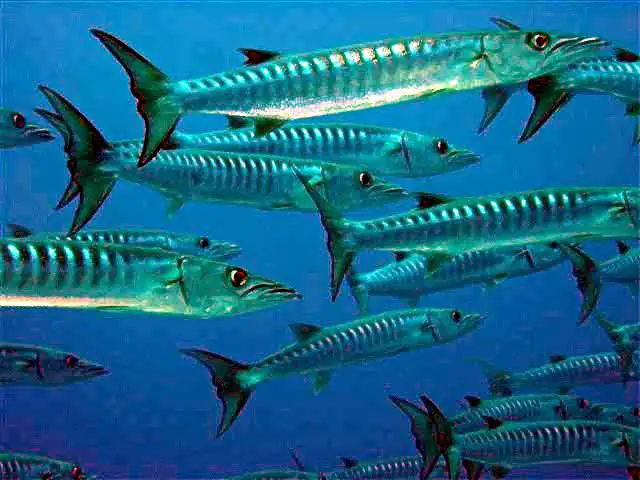
Where to Find:
- Barracuda are found in tropical offshore waters from Florida to Massachusetts.
- They are predatory fish who are also territorial. Look for thin, silver fish on sand banks, drop offs, and weed beds.
How to Catch:
- Barracuda are very territorial and aggressive, so if you put a tempting or threatening bait or lure near them they are very likely to strike.
- You can also try a topwater lure to see the fish strike with scary power.
Recommended Gear:
- Rod – 6-7 foot spinning medium action rod
- Reel – 6000 size spinning reel
- Fishing Line – 8-12 lb mono line with wire leader
Best Bait:
- Use fast moving lures, stickbaits or cut mackerel. Bring plenty of extra lures as the barracuda’s teeth can do some damage to your lures
Sturgeon
Sturgeon are large fish that reach sizes of about 8 feet and over 1000 pounds. They are very similar to sharks in appearance, but they have cartilage instead of bones and a 5-lobed tail fin instead of a shark’s triangular dorsal fin. Sturgeon also have five rows of razor-sharp teeth that they use to eat small animals like mussels and snails. The sturgeon can live to be over 100 years old, but their average lifespan is around 50 years.

Where to Find:
- Lake sturgeon are found in the Mississippi River, Hudson Bay and the Great Lakes, usually in depths of 15 to 30 feet.
How to Catch:
- Look for Sturgeon on your fish finder in deep holes – they are a BIG marker on your screen.
- Sturgeon are most active at night.
- Don’t set the hook, let the fish take the bait themselves.
Recommended Gear:
- Rod – 5 foot heavy conventional boat rod
- Reel – Heavy conventional offshore reel with 40 lb of drag
- Fishing Line – 60 – 80 lb braid line with 130 lb mono leader
- Fishing Hook – 7/0 octopus hooks
Best Bait:
- Lamprey, smelt, squid, and nightcrawlers are popular natural bait for Sturgeon
Cobia
Cobia, also called Black Kingfish or Grunter, is a popular sport fish that has been recorded at over 350 pounds. This fish has a unique appearance and taste and can be easily recognized by its two dorsal fins and black horizontal lines running across the body. Cobia are found in tropical to warm temperate waters (20-30 degrees Celsius; 68-86 degrees Fahrenheit) throughout the world. Cobia are considered coastal migratory fish because they live primarily along coastlines.
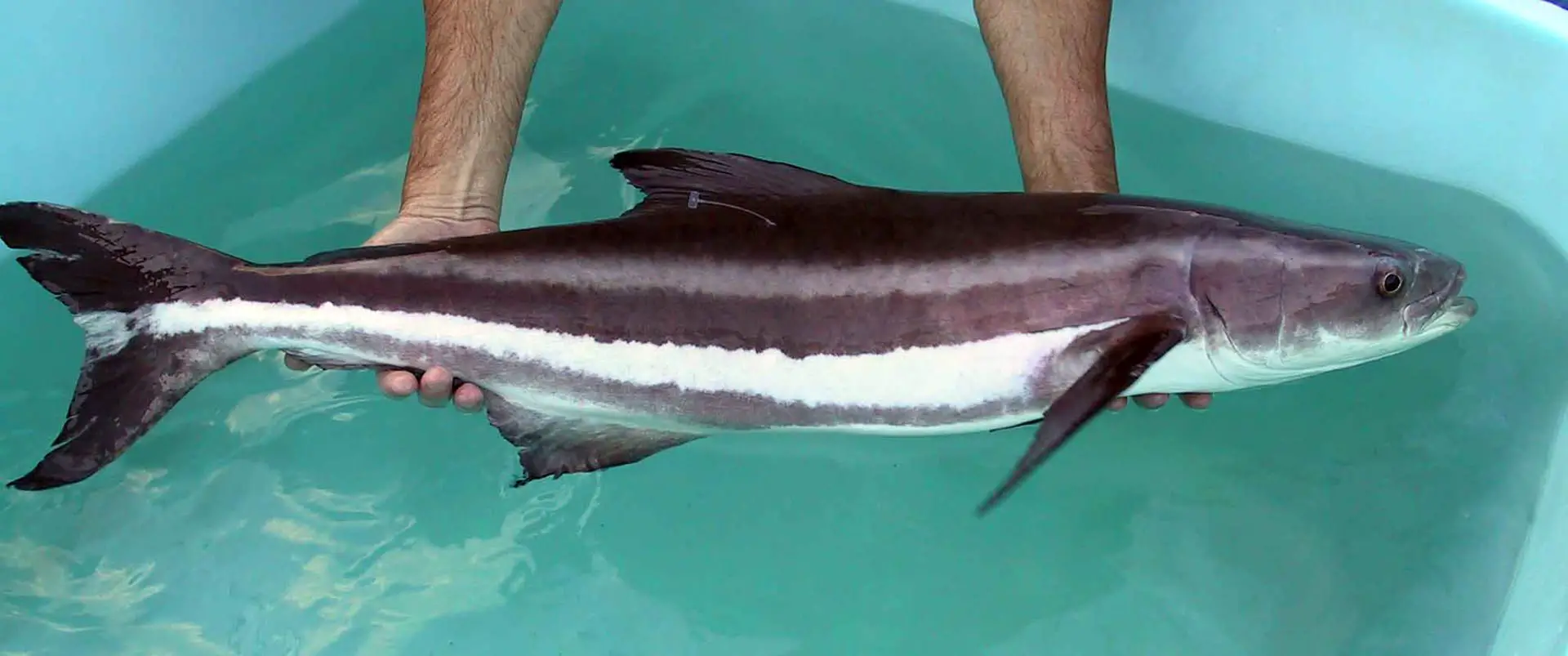
Where to Find:
- Cobia can be found at offshore reefs, around deep water structure like wrecks, and near navigation beacons.
How to Catch:
- Cobia are capable of long strong runs, and often have a second fight in them just when you think you have landed them.
- Large Cobia are often caught at night but can be caught throughout the day as well.
Recommended Gear:
- Rod – 7-9ft medium-heavy spinning rod
- Reel – A medium-heavy 5000-8000 size spinning reel
- Fishing Line – 30-50 lb braid with 30-50 lb mono leader
- Fishing Hooks – 7/0 circle hook
Best Bait:
- Popular natural bait for Cobia are plastic swimming eel, plastic crabs, fish, and livebait
Wahoo
The wahoo is a fairly large fish and can be found in tropical and warm temperate waters. It is also known as the dorado, great barred mackerel, Atlantic bluefish, giant amberjack and king mackerel. Despite its name, it is not actually a member of the tuna family at all. The wahoo has an olive green or blue back with white spots on its sides that meet at the belly region.

Where to Find:
- Wahoo are a pelagic species which means they live in the top of the water column. They are found in tropical waters from Mexico to Hawaii.
How to Catch:
- Wahoo can swim up to 60 miles per hour, so be prepared for a fight and make sure you have plenty of fishing line on your spool.
- Wahoo are often caught when anglers are chasing other gamefish like marlin and are attracted to similar styles and sizes of trolling lures.
Recommended Gear:
- Rod – 7-9 foot spinning rod
- Reel – 5000-8000 size heavy spinning reel with 30 lbs of drag
- Fishing Line – 80 lb mono line with wire leader
- Fishing Hooks – 6/0 circle hook
Best Bait:
- Wahoo are normally caught using a trolling lure
Roosterfish
Roosterfish are a group of perciform fishes found in tropical marine waters. They are part of the Labridae family. The roosterfish has few natural predators due to its sharp spines and tough skin, however it does fall prey to large shark species. Their flesh is firm and white with a mild flavor.

Where to Find:
- Roosterfish are found from Baja to Ecuador on sandy bottoms near baitfish. Look out for their distinctive dorsal fin.
How to Catch:
- Roosterfish put up a big fish for their weight and can fight for 30-45 minutes until their are landed.
Recommended Gear:
- Rod – 7-9 foot spinning rod with medium action
- Reel – 5000-8000 size spinning reels
- Fishing Line – 30 lb braid line with a 60 lb mono leader
Best Bait:
- The most popular bait for Roosterfish are livebait like mullet and bonito
- 6-7 inch poppers and stickbait are also effective
Sailfish
The Sailfish is found in tropical and subtropical oceans, mostly in salt water, but sometimes in brackish water. The sailfish is a fast and powerful swimmer that feeds on smaller fish. The sailfish uses its long bill to stun its prey with rapid side-to-side movements, much like the way a bird of prey strikes with its talons.
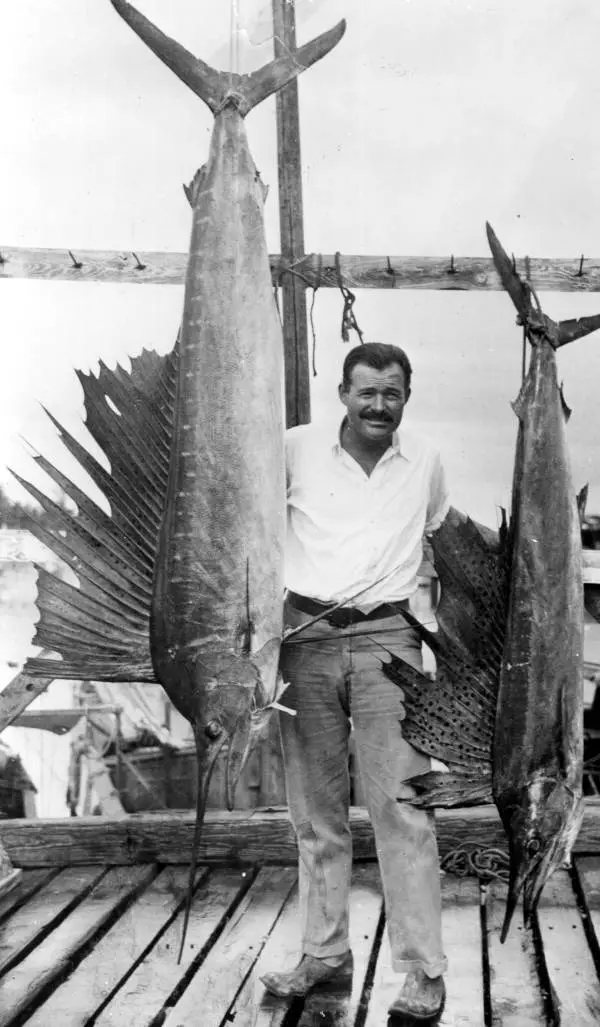
Where to Find:
- Sailfish are one of the worlds most popular gamefish and can be found in tropical offshore locations like Mexico, Florida, and Costa Rica.
How to Catch:
- Identify the position of a potential target by observing their noticeable sail movement around a school of bait fish.
- Troll past the hot zone with a skirted trolling lure and reflective teasers.
Recommended Gear:
- Rod – 5′ heavy boat rod
- Reel – Large conventional reel with hundreds of yards of spool capacity to fight a speeding sailfish
- Fishing Line – 30 lb mono with 80 lb mono leader
- Fishing Hooks – 6/0 circle hooks
Best Bait:
- Use a smaller trolling lure that can move fast through the water behind your boat.
Marlin
The marlin is a fish found in tropical areas of the Atlantic, Pacific and Indian Oceans. It is a popular game fish for sports fishermen, along with the related swordfish, from whom it can be distinguished by its bill, which is shorter and entirely uninterrupted from the head. The marlin has long pectoral fins and a deeply forked tail.

Where to Find:
- This is an artform that many charter captains have mastered. Look for the marlin surfaced in the distance or driving up baitfish then head in that direction.
How to Catch:
- Trolling with a heavy line, fighting belt, fishing chair, and deck hands is highly recommended.
Recommended Gear:
- Reel – Large conventional reel with over 500 yards of 80 lb mono line capacity and high maximum drag with a low gear ratio
- Rod – 5 foot heavy boat rod
- Fishing Line – 80 – 100 lb braid line with heavy leader
- Get yourself a sturdy gimbal fighting belt to save your back from a multiple-hour fight
Best Bait:
- Use a skirted trolling lure with several teasers to lure the marlin to the surface.
Mahi Mahi
Mahi Mahi is a large fish that lives in tropical waters. These fish are native to the Pacific Ocean, but have been introduced all over the world. They can be found as far north as Alaska, and as far south as Costa Rica. Because of this wide distribution, they are available around the world.
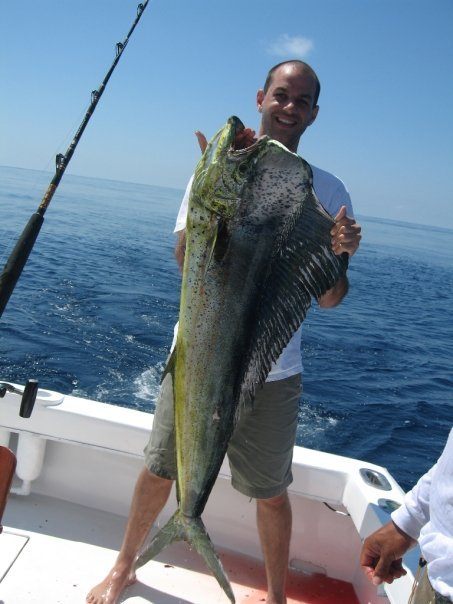
Where to Find:
- Mahi Mahi are found in tropical and subtropical oceans in the Gulf of California and from New Jersey to Florida
- They are surface dwellers and are often caught close to the surface
How to Catch:
- Mahi Mahi can be caught trolling, spinning, using live bait, and dead bait
Recommended Gear:
- Rod – 7 foot long conventional boat fishing rod
- Reel – Conventional boat fishing reel with 20 lb of drag
- Fishing Line – 30 lb braid line with 50 lb fluoro leader
- Fishing Hook – 4/0 to 7/0 circle hook
Best Bait:
- Popular baits for Mahi Mahi are sardines, mackerel, shrimp, and ballyhoo
- They can also be caught with skirted troll lures
Conclusion
Phew – that brings us to the end of this overview on North America Fish Species. Hopefully you have gained some knowledge about the most common angling species. We couldn’t include every possible fish species in this list but will be updating it in the future. Some other missing fish include Snapper, Squid, and Tilapia.
If there is a species missing that you think deserves to be in this list then please let us know in a comment below.
Obviously this only shows a brief summary of each fish – have a look at our individual fish tips for more detailed information.
This article on freshwater fish by the US Fish and Wildlife Service is also very helpful if you are looking for more information.
Happy fishing!
